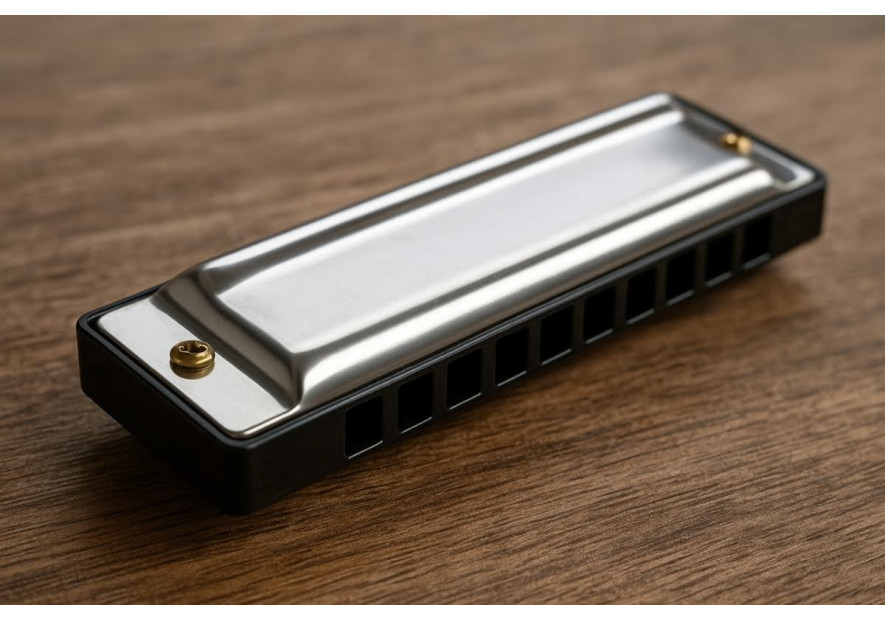Exploring the Different Types of Harmonicas [In-Depth Guide]
![Exploring the Different Types of Harmonicas [In-Depth Guide]](/img/anblog/b/b-67eaa4266a9c2-anblog_thumb.jpg)
When most people hear the word "harmonica," they picture a small, pocket-sized instrument with a wistful, bluesy sound—something pulled from a coat pocket on a lazy afternoon, played from the porch as the sun sets.
But here's the kicker: there isn't just one kind of harmonica. There are several types of harmonicas, each crafted with its own personality, tone, and musical role.
Whether you're a total beginner looking to choose your first harmonica or a seasoned musician expanding your collection, understanding the differences between various models can help you make the best choice.
Let’s break it all down without the jargon overload or stuffy textbook vibe.
The Diatonic Harmonica: The Go-To for Blues, Rock, and Folk
This one’s the classic. The diatonic harmonica (often called a "blues harp") is what you’ll hear in old-school blues, folk ballads, and a surprising amount of modern rock.
It's typically tuned to a specific key and built for a particular scale—usually major—but that doesn’t mean it’s limited. Skilled players use bending techniques to hit those gritty, soulful notes that don’t technically exist on the instrument.
Kind of like squeezing out hidden sounds with nothing but breath and feel.
Diatonics are compact, expressive, and incredibly emotional—great for storytelling through music.
If you're just starting and want to feel like a harmonica hero sooner than later, this one might be your best bet. Plus, there's an entire world of modifications and tunings once you get the basics down.
Chromatic Harmonica: Where Jazz and Complexity Collide
Think of the chromatic harmonica as the diatonic’s more sophisticated cousin. It's larger, heavier, and—let’s be honest—a little intimidating at first glance. What makes it different? The button is on the side.
That button activates a sliding bar that shifts the pitch up a half-step, essentially giving you access to every note in the Western scale.

That means you can play in any key without switching harmonicas. It’s a huge advantage if you're into jazz, classical, or pop melodies that require more nuanced movement between keys.
But there's a tradeoff: it’s harder to learn. The reeds are arranged differently, the button takes some getting used to, and bending notes (the lifeblood of blues) aren’t as fluid here.
Still, if you love smooth runs and rich chordal passages or just want to sound like Stevie Wonder, the chromatic is calling your name.
Tremolo and Octave Harmonicas: The Shimmer and Shine of the Harmonica World
Now, let’s talk about sound texture—those shimmering, chorus-like effects that give some harmonica tones a kind of dreamy glow. That’s the realm of tremolo and octave harmonicas.
Tremolo harmonicas use two reeds per note—one tuned slightly higher than the other. When played together, they create a wavering, vibrating effect that sounds almost like two instruments dancing in harmony.
You’ll hear these often in traditional Asian music, as well as European folk tunes. They’re beautiful, light, and kind of hypnotic.
Octave models work similarly, but instead of slightly detuned reeds, they use reeds an octave apart. The result? Octave harmonicas have fuller, punchier sounds with a solid backbone. Think of it as turning up the bass without losing clarity.
Both of these are more niche, sure, but they’re also great if you're chasing a specific vibe or want to stand out in an acoustic jam session.
Bass and Chord Harmonicas: The Backbone of Ensemble Play
Okay, so this is where things get a little wild. If the diatonic and chromatic harmonicas are solo artists, the bass and chord harmonicas are the rhythm section.
Bass harmonicas are big—like really big—and they sound just like you’d expect: deep, thumpy, and almost tuba-like.
They’re not usually used for solo playing, but in harmonica ensembles, they lay down the groove, providing that rich low-end foundation that everything else builds on.

On the other hand, chord harmonicas look like someone welded a bunch of harmonicas together (because, in a way, they did).
Each section plays a different chord, allowing you to switch between major, minor, seventh, and diminished chords on the fly. It’s a lot to manage, but in the right hands, it’s pure magic—perfect for creating lush harmonic backdrops in group settings.
Sure, you won’t be pulling one of these out of your back pocket at a campfire anytime soon, but they’re essential for ensemble players who want to build layered, orchestral harmonica music.
Specialty Harmonicas: When You Want to Break the Rules
Here's where it gets quirky—and a little fun. Specialty harmonicas exist for those who want to bend the traditional rules or explore uncharted sonic territory.
Some are tuned to minor scales right out of the box. Others are designed specifically for country, reggae, or Celtic music.
There are even harmonicas that blend features—like a diatonic body with a chromatic slide—giving players more control and flexibility in one instrument.
These hybrids might not be the first stop for beginners, but they’re gold for players who already know what they want or just want to mess around with something new.
Whether you're after a specific scale, genre, or sound effect, this is where you can get creative and personalize your playing style.
So… Which Harmonica Is Your Harmonica?
Choosing between different types of harmonicas isn’t just a technical decision—it’s a personal one. It’s about the kind of music you’re drawn to, the way you want to express yourself, and sometimes, the mood you're in when you pick it up.
Are you a bluesy storyteller looking to pour your soul into every bend? Grab a diatonic. Want to impress your jazz trio with buttery chromatic runs? That button's your new best friend.
And for those just starting out, there are plenty of beginner-friendly models that can help you practice the essential harmonica techniques needed to grow and improve as a player.
Feel like creating a soundscape no one expects? Maybe it’s time to try something from the specialty shelf. There’s no wrong choice—just different doors leading to different musical worlds.
Ready to Find Your Sound?
At the end of the day, your harmonica should fit you—your hands, your breath, your story.
Whether you’re starting or stepping into more advanced territory, understanding the types of harmonicas is the first real step toward finding your unique voice.
And if you’re wondering where to begin (or continue), HARMO’s got your back. We offer a curated selection of harmonicas - from high-quality diatonic and sleek chromatics to beautifully designed specialty models.
Every harmonica we craft is built with precision, passion, and that extra bit of soul. Because sometimes, the right harmonica isn’t just an instrument—it’s an extension of who you are.
Contact us today, and let us help you choose the perfect harmonica to start your musical journey!



Leave a comment